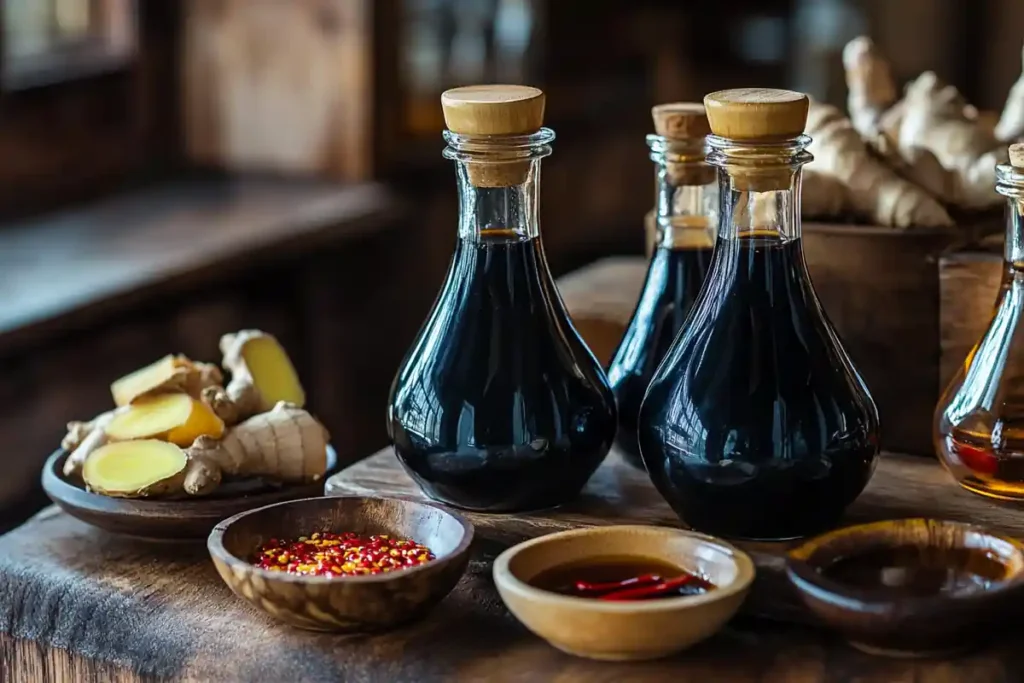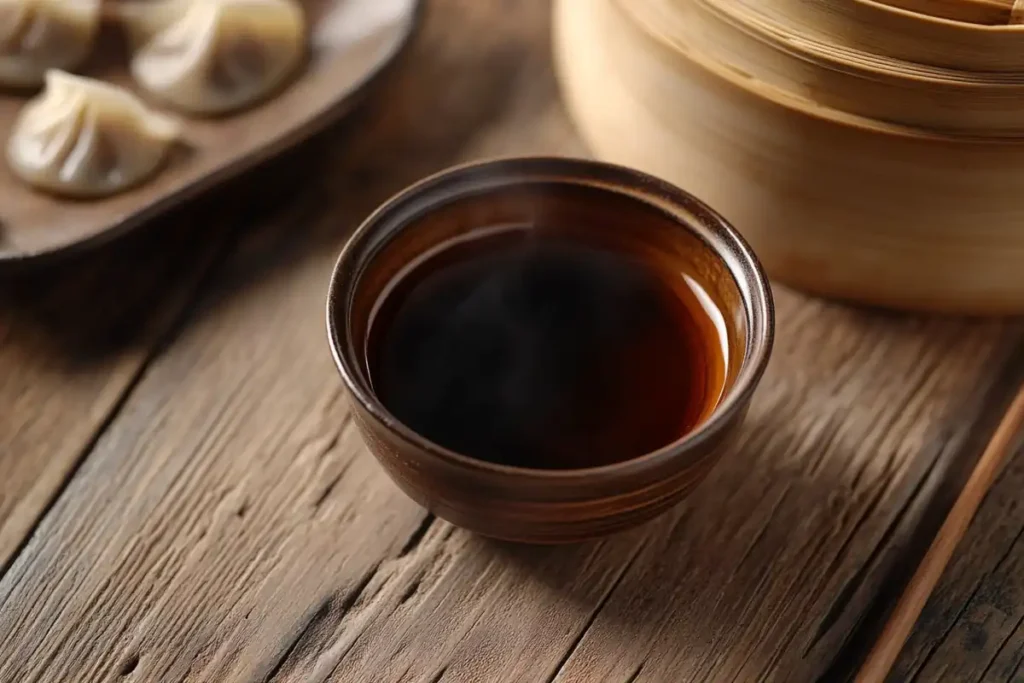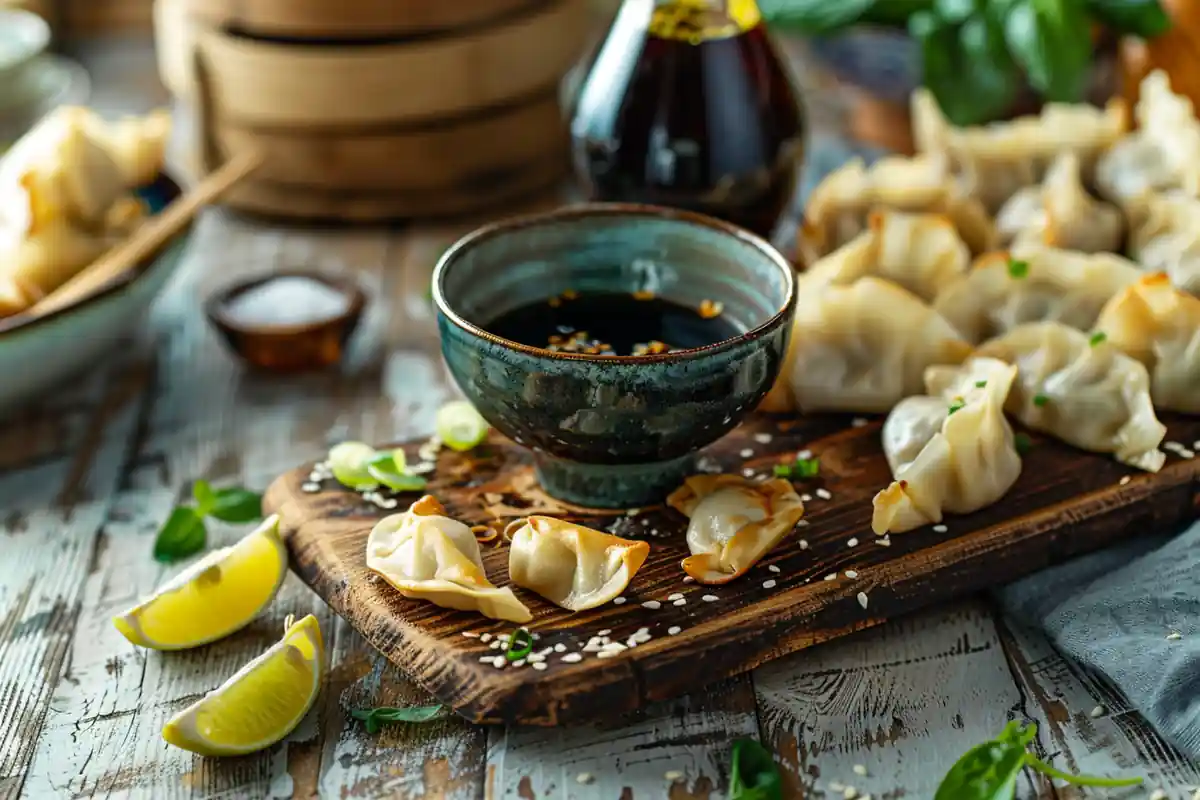Din Tai Fung’s vinegar-based dipping sauce is a true flavor explosion, elevating dumplings, wontons, and even salads with its perfect balance of tanginess and umami. Many food enthusiasts have tried to replicate this iconic condiment at home, but capturing its magic requires more than just tossing ingredients together. In this article, we’ll guide you step-by-step on how to make Din Tai Fung vinegar, covering everything from the essential ingredients to perfecting the right proportions.
Let’s unlock the secrets to this tantalizing sauce and explore its delicious versatility!
1: Introduction to Din Tai Fung Vinegar
What Makes Din Tai Fung Vinegar Unique?
Din Tai Fung’s vinegar sauce isn’t your run-of-the-mill dipping sauce. Its core ingredient, Chinese black vinegar, delivers a distinct tangy depth that sets it apart from Western-style vinegars. When paired with soy sauce and optional spices, this magical combination adds a layer of sophistication to dishes like dumplings and wontons.
What truly makes it stand out is its balance. It’s not overly sour, salty, or sweet. Instead, it plays beautifully with the umami-rich soy sauce and subtly spicy chili oil (if you’re feeling adventurous). This perfect harmony is why it’s adored by food lovers worldwide.
A Brief History of Din Tai Fung and Its Signature Vinegar
Din Tai Fung began as a humble cooking oil business in Taiwan before transforming into a global culinary icon specializing in dumplings and noodles. Its signature vinegar blend has become a hallmark of its dishes, particularly their world-famous xiaolongbao (soup dumplings). Over the years, fans have attempted to recreate this dipping sauce at home, sparking a love for experimenting with black vinegar recipes.
Overview of Ingredients and Flavor Profile
At its heart, Din Tai Fung’s vinegar is about achieving that perfect balance of:
- Tanginess from Chinese black vinegar
- Saltiness from soy sauce
- Aromatics and heat from optional additions like garlic, ginger, and chili oil
The sauce’s sweet-and-sour tang complements the richness of dumplings without overpowering their delicate flavor. It’s no wonder it’s become a fan favorite!
2: Essential Ingredients for Din Tai Fung-Style Vinegar

Chinese Black Vinegar: The Core Ingredient
To create authentic Din Tai Fung vinegar, you’ll need to start with Chinese black vinegar. This ingredient is the cornerstone of the sauce, offering a unique tangy and malty flavor that’s difficult to replicate. Zhenjiang vinegar, also known as Chinkiang vinegar, is the most popular choice for this recipe.
If Zhenjiang vinegar isn’t available, you can substitute it with other varieties like Shanxi vinegar or even balsamic vinegar in a pinch. However, the latter tends to be sweeter, so you may need to adjust the proportions to maintain the balance.
Soy Sauce as a Supporting Ingredient
Soy sauce plays a vital role in balancing the acidity of black vinegar with a salty, umami richness. Light soy sauce is often recommended for its milder flavor, but if you prefer a deeper, more robust profile, dark soy sauce works too. Feel free to experiment with different types of soy sauce to suit your taste.
Optional Additions: Enhancing the Flavor
While the traditional Din Tai Fung vinegar is a simple mix of vinegar and soy sauce, optional ingredients can elevate its complexity. Consider adding:
- Garlic or ginger: For a bold aromatic twist.
- Chili oil: To give the sauce a spicy kick.
- Sesame oil: For a nutty, fragrant touch.
- Sugar or honey: To mellow out any excessive tanginess.
3: The Perfect Ratio – How to Mix Din Tai Fung Vinegar
Standard Ratio for Authentic Flavor
The secret to mastering Din Tai Fung vinegar lies in the perfect ratio. The classic combination is three parts black vinegar to one part soy sauce, which creates a harmonious blend of tangy, salty, and umami flavors. This ratio works wonderfully as a base for dumpling dipping sauce.
Adjusting the Ratio for Different Palates
Not everyone has the same taste preference, and that’s the beauty of this sauce. If you like a tangier kick, increase the amount of black vinegar slightly. For a sweeter touch, add a pinch of sugar or a dash of honey. Balancing the ratio to your liking ensures the sauce complements, rather than overpowers, your dish.
Integrating Optional Ingredients for a Custom Twist
Once you’ve nailed the base ratio, it’s time to get creative. Stir in chili oil for heat or sesame oil for a nutty richness. For those who enjoy bold flavors, finely minced garlic or grated ginger can add a punch of freshness. The key is to taste as you go, ensuring each ingredient enhances rather than competes with the others.
4: Pairing Din Tai Fung Vinegar with Dishes
Dumplings and Wontons: A Match Made in Heaven
Din Tai Fung vinegar was crafted to complement dumplings and wontons. Its tangy, umami-rich flavor enhances the delicate taste of xiaolongbao (soup dumplings) and other steamed or fried dumplings. The sauce balances the richness of the filling, making each bite irresistibly flavorful.
To serve, simply pour the vinegar into a dipping dish, add finely shredded ginger if desired, and watch your dumplings come to life. For an extra zing, drizzle a little chili oil into the mix.
Cucumber Salad and Other Cold Dishes
Din Tai Fung vinegar also works wonders as a dressing for cold appetizers like cucumber salad. The tanginess of the sauce pairs beautifully with the crunch of fresh cucumbers. A splash of sesame oil and a pinch of sugar can turn this into a refreshing side dish perfect for summer meals.
For an easy recipe, you can explore our Din Tai Fung Cucumber Salad Recipe for step-by-step instructions.
Using the Vinegar for Cooking or Marinades
Beyond dipping, this versatile vinegar mix can be used as a marinade for meats or a seasoning for stir-fries. Combine it with garlic, soy sauce, and a dash of sugar to tenderize chicken, pork, or beef before grilling. Alternatively, toss it into a stir-fry to give your veggies a savory-sour punch.
5: Common Mistakes to Avoid When Making Din Tai Fung Vinegar
Using the Wrong Type of Vinegar
Not all vinegars are created equal. Substituting black vinegar with rice vinegar or white vinegar may drastically alter the flavor. If you can’t find Zhenjiang vinegar, consider Shanxi vinegar or another Chinese black vinegar for the closest match. Using balsamic vinegar is an option, but it’s sweeter and may require adjusting the ratios.
Overpowering the Flavor with Soy Sauce or Chili Oil
While soy sauce and chili oil are key components, overusing them can drown out the unique tanginess of black vinegar. Stick to the recommended ratios and taste-test as you go to maintain balance.
Not Balancing the Sweetness Properly
Sweetness plays a subtle but vital role in balancing the bold flavors of vinegar and soy sauce. Skipping sugar or honey can result in a sauce that’s too sharp. On the flip side, adding too much can make the sauce cloyingly sweet. Start with a small amount and adjust to taste.
6: FAQs About Din Tai Fung Vinegar
What Is the Best Black Vinegar to Use?
When learning how to make Din Tai Fung vinegar, choosing the right black vinegar is crucial. Zhenjiang vinegar, also called Chinkiang vinegar, is the most authentic choice. Its deep, tangy flavor closely mimics the taste used at Din Tai Fung. If you can’t find it, Shanxi vinegar is another great option. Avoid using rice vinegar or white vinegar, as their flavor profiles differ significantly.
Can I Use Rice Vinegar Instead of Black Vinegar?
Rice vinegar is much lighter and less complex than black vinegar. While it can be used in a pinch, it won’t deliver the same depth of flavor. If substituting, try adding a dash of soy sauce and a drop of molasses to replicate black vinegar’s rich profile.
How Long Does Homemade Din Tai Fung Vinegar Last?
The good news is that your homemade Din Tai Fung vinegar has a long shelf life! Store it in a clean, airtight jar in the fridge for up to two weeks. If you add fresh ingredients like garlic or ginger, consume it within a week for the best flavor.
What Are Some Vegetarian Substitutes for Soy Sauce?
For a vegetarian-friendly version of this recipe, you can use tamari or coconut aminos instead of soy sauce. Both options maintain the sauce’s umami without compromising on flavor.
Can I Add Other Ingredients to Customize the Vinegar?
Absolutely! One of the joys of making your own Din Tai Fung vinegar is the ability to customize. You can add finely shredded ginger for a fresh zing or a teaspoon of sesame oil for a nutty aroma. If you love spice, mix in chili oil or freshly minced chilies. The possibilities are endless, and experimenting ensures you create a sauce that suits your unique palate.
7: Tips for Mastering Din Tai Fung Vinegar at Home
Experimenting with Proportions to Suit Your Taste
The beauty of making Din Tai Fung vinegar at home is the ability to customize it to your liking. If you love tangy flavors, add an extra splash of black vinegar. For a sweeter finish, a teaspoon of honey or sugar can go a long way. The key is to experiment until you strike the perfect balance.
Adding Aromatics Like Ginger or Scallions
Aromatics can elevate your vinegar to a whole new level. Finely shredded ginger is a classic addition, providing a fresh, spicy contrast to the vinegar’s acidity. Thinly sliced scallions can add a subtle sharpness, making the sauce even more versatile.
How to Store and Reuse Leftover Vinegar Mixture
Storing your leftover Din Tai Fung vinegar is easy. Transfer it to a clean, sealable jar and refrigerate. Before reusing, give it a good shake to redistribute the ingredients. If it thickens over time, a small splash of water can help restore its original consistency.
8: Exploring Variations of Din Tai Fung Vinegar
Sweet and Tangy Version
If you love a slightly sweeter twist, creating a sweet and tangy version of Din Tai Fung vinegar is easy. Simply add a teaspoon of sugar or honey to the original recipe. This variation is perfect for dishes like spring rolls or crispy fried dumplings, as it balances out the richness with a touch of sweetness.
When experimenting with this version, always taste-test as you go. Too much sugar can overpower the tangy essence of the vinegar, so aim for harmony.
Spicy Kick Variation
For those who enjoy a bit of heat, adding chili oil is the way to go. Start with a teaspoon and increase based on your spice tolerance. This spicy version pairs wonderfully with wontons or noodles, giving the sauce a fiery depth.
You can also sprinkle in some crushed red pepper flakes or minced fresh chili for extra boldness. The combination of tanginess and spice creates an unforgettable flavor experience.
9: Why You Should Try Making Din Tai Fung Vinegar at Home
Cost-Effective and Customizable
One of the biggest benefits of learning how to make Din Tai Fung vinegar is the cost savings. While dining at the restaurant is a treat, making the sauce at home is far more economical. Plus, you can adjust the ingredients to suit your taste preferences, whether you like it spicier, sweeter, or tangier.
Impress Your Guests with Homemade Flavors
Serving your homemade Din Tai Fung vinegar to friends and family is sure to impress. This versatile sauce elevates everything from dumplings to salads, making your meals feel restaurant-quality. By customizing the sauce, you can cater to different palates and showcase your culinary creativity.

A Gateway to Exploring Chinese Cuisine
Making your own Din Tai Fung vinegar is an excellent introduction to the world of Chinese culinary traditions. Once you master this dipping sauce, it opens the door to trying other classic recipes like xiaolongbao (soup dumplings), spicy wontons, or even simple stir-fries. It’s a small step into a rich, flavorful cuisine that encourages experimentation and creativity in the kitchen.
Healthier and Fresher Than Store-Bought Options
Homemade sauces often have one big advantage over store-bought versions: freshness. By making your own Din Tai Fung vinegar, you can control what goes into it. No preservatives, no artificial flavors—just wholesome, fresh ingredients. It’s not only tastier but also a healthier option for you and your family.
Plus, by making small batches as needed, you always have the freshest sauce on hand. No more worrying about expiration dates or unwanted additives.

